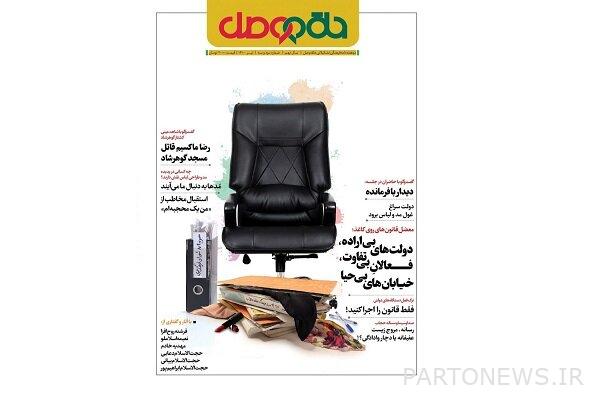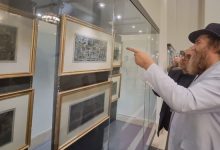The new issue of “Halaghe Vasal” magazine has been published – Mehr News Agency | Iran and world’s news

According to the Mehr news agency, issue 93 of the cultural publication, the “Circle of Wesl” organization, has examined this important issue at the same time as the week of chastity and hijab, and in this issue it has examined the country’s legal approvals on this issue and the inattention of government agencies. .
Involuntary governments, indifferent activists, lifeless streets
The editorial of this issue of the magazine, written by Sadegh Yazdani, the editor-in-chief of the magazine, deals with two resolutions of the Supreme Council of the Cultural Revolution regarding chastity and hijab. Yazdani points out: “Perhaps one of the best guidelines in the field of chastity and hijab is a law that was approved by the Supreme Council of the Cultural Revolution in 2005, which specifies the duties of all agencies and institutions in detail. “This resolution, known as 427, was prepared with many studies and studies in the Public Culture Council and then approved by the Supreme Council of the Cultural Revolution, but despite the fact that three presidents have seen it, no effective steps have been taken to implement it.”
The author emphasizes: “The law is good when it is written for implementation, to be the executor of it, and for a power to monitor its implementation and hold accountable the bodies responsible for implementation. “What happened that three different governments had no will to implement this law and no one approached them and took their collars?”
Fashion and clothing giants
The “Lal” section of this issue has explained activities in the field of chastity and hijab in various conversations and notes.
In a note, Hojjat Haji Kazem discusses the duty of the elected government regarding the issue of hijab, and mentions the main issue as confronting the fashion and clothing giant, and considers the government obliged to fight this giant.
In a note, Seyed Sajjad Jelini examined the historical incident of the crime in Goharshad Mosque and asked the audience to help the movement to collect memories about this bitter incident. Hojjatoleslam Pourali has also given a short narration of this historical event.
In a conversation with Fereshteh Rouhnavaz, Halaghe Vasal answered the question, “Why should we wear hijab?” In this issue, Rouhanavaz has a cordial and heartfelt conversation with the audience of the magazine and has serious criticisms about the way cultural groups work in the field of hijab. He also complains about the negligence of the authorities and claims that his wife – the martyr Dr. Hatami – had reached a mathematical model for the problem of hijab that solved many of these problems.
In a note, Hossein Delavari discusses the relationship between the media and the issue of coverage. Mahdieh Khadem, in a note entitled “Abandoning the actions of government agencies and the need for activists to demand”, examines in detail the resolutions 427 and 820 of the hijab and blames the government agencies in the meantime. He believes that cultural activists do not make any demands on this issue.
In a conversation with Naeema Islamloo, Halaghe Vasal also analyzed the legal approvals of hijab and chastity and the performance of government agencies. In this conversation, Islamloo has also made serious references to the issue of cyberspace and its relation to the issue of modesty and chastity.
Also in this issue, during a photo gallery, the most important tasks of the governing bodies in the field of chastity and hijab are depicted.
Meet the commander
The “porch” section of this issue, which is connected to the historical event of the meeting of activists in the field of hijab and chastity with the Supreme Leader of the Revolution in 1397, and in a conversation with several people present at the meeting, has narrated narrations from this meeting.
Fashions follow us
The “knot” section of this issue deals with the issue of fashion in society and explores the pros and cons of this phenomenon.
We want to connect the loop
The “Sarv” section, number 93 of the connection circle, went to two institutions active in the field of chastity and hijab, and in a conversation with the officials of these institutions, examined their activities.
The Hijab Book Office is one of these institutions that collects various books on chastity and hijab and introduces them to the audience in various forms. Mohammad Rezakhani, the head of this institute, believes that he wants to be the connecting link between the institutions active in the matter of chastity and hijab. Of course, there are many problems in the path of this connection.
Also, Jamal Taheri, in a conversation with the connected circle about the “Eduardo” Institute, which operates in Isfahan, examined the efforts of this institute in the field of hijab, especially the hijab of the newcomers, and examined the different experiences of this old institute. Has set.
Crystallization of Shiite protest
The “sincerity” section of this issue has also published historical and interesting interviews with the late Hojjatoleslam Montazer Ghaem (father of martyr Mohammad Hassan Montazer Ghaem). He was one of the eyewitnesses of the Goharshad mosque tragedy and was present in the mosque that bloody night and was able to escape from this catastrophe with difficulty. This interview is readable, sweet and at the same time bitter and horrible.
The publication is published by Sadegh Yazdani, Managing Director and Editor-in-Chief. To receive this publication, you can call 021-88395324. Also, for information on the latest news and reports of the Cultural Front of the Islamic Revolution, you can use the Hvasl.ir website and the “Qadh” section of the magazine.
.

